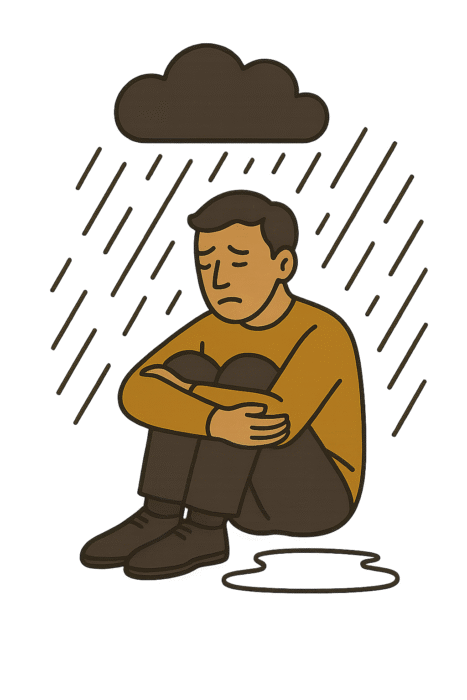Many men reach a point in their forties or fifties where life begins to feel heavy in unexpected ways. Projects that once felt meaningful seem hollow. Achievements don’t bring the satisfaction they promised. A quiet question rises: Is this what life was supposed to be?
This experience is often called a midlife crisis. But what does that really mean? And how can a man navigate this turning point in a way that leads to deeper purpose rather than despair?
In this article we will explore:
- What is a midlife crisis? — myths vs. psychological reality
- Why men are particularly vulnerable
- How Existential Analysis & the Four Fundamental Motivations shed light on it
- Practical strategies to respond with growth
- Internal links to related resources
- A call to exploration and hope
What Is a Midlife Crisis?
A midlife crisis is often portrayed in movies and culture as dramatic acts: buying sports cars, quitting jobs, having affairs. But real midlife crisis is subtler — a profound inner turmoil about meaning, identity, legacy, and mortality.
Psychologists define it as a period where one becomes acutely aware of life’s finitude and questions whether what they’ve done so far is enough (Lachman, 2004). It typically occurs between ages ~35 and 60, though timing and intensity vary.
Key features include:
- Feeling time is running out
- Regret or doubt about past choices
- Desire for radical change
- Emotional volatility, low mood, restlessness
- Identity questioning: Who am I now?
When a man asks, “What is a midlife crisis?”, he may already be experiencing emptiness, restless dissatisfaction, or estrangement from his younger aspirations.
Men in midlife may also face unique pressures: career decline or plateau, concerns about aging and health, shifting familial roles (children growing up, aging parents), and cultural expectations about masculinity and success.
Why Men Are Vulnerable to Midlife Crisis
Some reasons midlife can feel more destabilising for men:
- Cultural narrative of “getting it right”: Men often feel they must succeed in work, provide, and be strong. When achievements feel less satisfying, identity may feel hollow.
- Less emotional social network: Many men have fewer deep friendship spaces to explore struggle and vulnerability.
- Physical changes & mortality: Aging, health issues, diminished vitality make one more aware of death and change.
- Loss of novelty & youth: Youthful dreams, energy, and possibilities begin to fade — creating emotional tension when ambition remains.
This can trigger existential anxiety: “Did I waste my life?”, “Am I living authentically?”, “What now matters?”
Existential Analysis & Midlife Crisis
Existential Analysis (EA) — rooted in Viktor Frankl’s Logotherapy and expanded by Alfried Längle — offers a rich way to understand midlife as an invitation rather than failure.
Recall the Four Fundamental Motivations:
- Space, Protection & Support
- Fulfillment, Affection & Values
- Authenticity & Self-Worth
- Meaning & Purpose
Midlife crisis often arises when one or more of these motivations has been neglected for decades.
- A man may have built external success (jobs, possessions) but neglected internal fulfillment (Motivation 2).
- He may have sacrificed authenticity for role conformity (Motivation 3).
- The question of legacy and life meaning becomes strong (Motivation 4).
- If life has felt stressful, unsafe, or lacking support, his sense of space and security (Motivation 1) may be weak.
In EA, the crisis is not a failure — it’s a signal that your life is off-course relative to your deeper needs. The path forward is not to patch over the emptiness, but to realign your life with what matters to you now.
Men in crisis often ask: Why do I feel lonely, even in relationships? or Why does life feel empty despite what I’ve built? Related reading: Loneliness & Depression in Men: Existential Perspective. Also see how one can re-engage purpose after change: Reconnecting With Purpose After a Major Life Change.
Signs You Might Be in a Midlife Crisis
- Persistent inner unrest or dissatisfaction
- Loss of enthusiasm for things you once loved
- Drifting in relationships or feeling disconnected
- Fantasies of radical change (career, location, relationships)
- Emotional volatility — mood swings, depressive dips
- Physical signs: fatigue, sleep problems, health anxiety
What to Do: Navigating Midlife With Intention
Here are steps grounded in Existential Analysis to respond with growth:
1. Reflect on Your Motivations
Use a structured reflection (via Mountain Framework) to see which motivations feel starved:
- Which core needs (safety, connection, authenticity, meaning) feel unmet?
- How have you prioritized external roles at the cost of inner life?
2. Explore Your Journey
Write or think:
- What dreams have I abandoned?
- What parts of me have I silenced?
- When did I begin feeling disconnected or hollow?
Understanding your biography (as EA encourages) helps you reclaim lost pieces of self.
3. Decide with Alignment
Use Personal Existential Analysis:
- Facts / Perception: What is my current reality?
- Emotions / Values: What feels painful? What do I deeply care about?
- Value-Based Decision: What is one move I can make now in service of who I want to be?
- Act: Do it (even a small step).
4. Rebuild Your Purpose
Midlife can be a launching point for deeper purpose. Reflect on:
- What have you contributed already, and what remains to give?
- How can you engage in new projects aligned with your values?
Use the Quest for Meaning: 10 Exercises on Purpose to help reorient.
5. Surround Yourself with Depth
Seek companions who can hold deeper conversation — men’s groups, therapy, spiritual communities.
Having a companion helps you sustain overhauls beyond a single burst of change.
Dealing With Resistance & Fear
Midlife change often triggers fear:
- Fear of failure, shame, loss
- Identity anxiety: If I let go of who I have been, who will I become?
- Practical worries: financial, relational consequences
Existential Analysis teaches us to face anxiety as part of freedom:
“Between stimulus and response, there is a space. In that space we grow.”
Lean into the discomfort. Use courage to choose value over safety.
A Man’s Midlife Crisis Is Also a Gateway
Rather than a breakdown, midlife crisis can be a breakthrough—an invitation to grow more deeply, reconnect to purpose, and live with greater authenticity. It’s a call to revision, to align life with inner truth rather than external expectations.
If you’re asking “What is a midlife crisis?” or silently wondering “Why do I feel lonely even though I built so much?”, know that change is possible.
If you’d like guided reflection for this season of life — check out our toolset: FM Reflection Cards, Mountain Cards, and Decisions Cards in the Meaningful Paths App.
Final Thoughts & Call to Action
Midlife crisis in men is often framed as fear, failure, or crisis — yet it can become a sacred turning point. When voluntary reflection meets existential invitation, you can re-emerge with clarity, depth, and renewed purpose.
If you want a companion on this journey, our Quest for Meaning: 10 Exercises on Purpose offers guided introspection grounded in Existential Analysis.
May this turning point become not your end, but your most purposeful beginning.
References
- Frankl, V. E. (2006). Man’s search for meaning. Beacon Press.
- Längle, A. (2016). The search for meaning in life and the existential fundamental motivations. Existential Analysis, 27(1), 4–12.
- Lachman, M. E. (2004). Development in midlife. Annual Review of Psychology, 55(1), 305–331. https://doi.org/10.1146/annurev.psych.55.090902.141521
- Wong, P. T. P. (2012). Toward a dual-systems model of what makes life worth living. In P. T. P. Wong (Ed.), The human quest for meaning: Theories, research, and applications (2nd ed.). Routledge.
- Cacioppo, J. T., & Patrick, W. (2008). Loneliness: Human nature and the need for social connection. W. W. Norton & Company.

